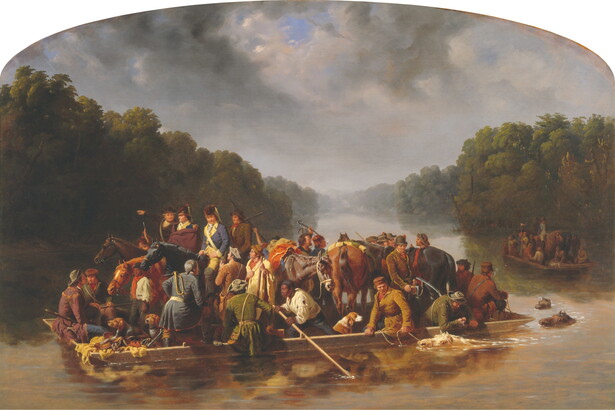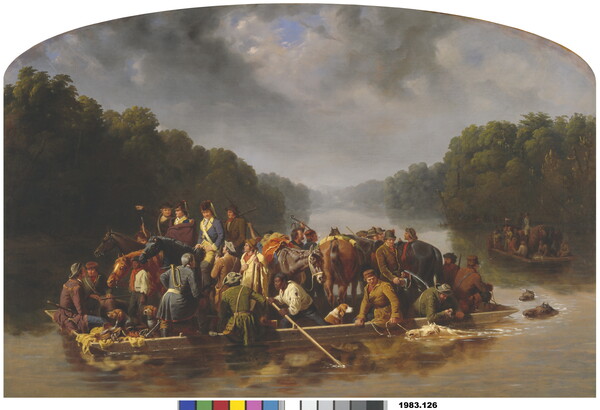


Artwork Images
Photo:
Controls
Marion Crossing the Peedee
Object Details
-
Date
1850
-
Object Type
Paintings
-
Medium
Oil on canvas
-
Dimensions
50 1/8 x 74 3/8 in.
-
Inscriptions
Recto:
signed and dated l.c.: W Ranney \ 1850
Verso:
[removed] printed paper label: LOS ANGELES COUNTY MUSEUM OF ART \ Los Angeles, California \ No.: L. 75.17[typewritten] \ ARTIST: William Ranney (American, 1813-1857) [typewritten] \ TITLE: Marion Crossing the Peedee. [typewritten and underlined] 1850 [typewritten] \ MEDIUM: Oil on fabric. [typewritten] \ Collection of Dr. and Mrs. Franz [typewritten] \ SOURCE: Stenzel [typewritten] \ Size: 50 x 74" (127.0 x 188.0 cm.) [typewritten] \ 76l49Z - Cdb 8-69
[removed] typewritten label: Taken From \ Cyclopedia Of American \ Biography \ ---- \ W. Ranney, Artist, born in Middletown, Conn., \ May 9, 1813, died in West Hoboken, N. J. November \ 18, 1857. The name that was given him at baptism \ was William Tylee but he never use [sic] the latter. \ Ath [sic] the age of thirteen he was taken to Fayetville, \ N. C. by his uncle where he was apprenticed to a \ tinsmith but seven years later he was studying draw- \ ing in Brooklyn. When the Texan struggle began \ Ranney enlisted and during the campaign became ac- \ quainted with many trappers and guides of the west. \ After his return home he devoted himself mainly to \ [torn] aying their life and habit. Among his works \ [torn] 's First View of Kentucky", "On The Wing", \ [torn] Mission To The Indians", (1847) \ [torn] ry, \ [torn] 's
[attached to frame] label: Tracy & Newkerk of 124 Grand Street, New York
-
Credit Line
Amon Carter Museum of American Art, Fort Worth, Texas
-
Accession Number
1983.126
-
Copyright
Public domain
Object Description
During the 1850s, as conflicts over slavery escalated in the United States, history became a battleground. Northerners and Southerners fought over the memory of the Revolutionary War, with pro-slavery writers touting the importance of the Southern enslavers who fought the British. Amid this culture war, Ranney completed this large history painting showing the forces of General Francis Marion, a South Carolina enslaver who led a 1780 campaign against the British.
Ranney’s personal views on slavery are unknown, but his picture underscores Marion’s reliance on Black labor: At the center, a Black man—identified as Oscar Marion, the general’s enslaved attendant—rows the barge across the Peedee River. Posed in this way, Oscar is essential to the action, yet he remains subordinate to his White counterparts. However, it is not obvious whether this is a visual statement for or against slavery. Ranney unveiled this work in New York City, a hotbed of sectional tensions; perhaps he wanted his picture to appeal to pro- and anti-slavery viewers without appearing to favor one side.
—Text taken from the Carter Handbook (2023)
Additional details
Location: On view
See more by William Tylee Ranney
Tags
-
Ranney’s large history painting of a Revolutionary War southern military campaign shows a wooden barge crossing a river in a wooded area, hangs in an ornately carved, gold frame, and takes up a large spot on the gallery wall. The shape of the artwork is mostly rectangular, but the top edge of the canvas is subtly arched. The main action in the scene is colorful, while the natural surroundings are muted earthtones. Between the shape of the canvas and the bright color palette of the main details, the viewer is immediately drawn to the middle of the painting.
The central focal point of the canvas is the large wooden barge carrying a big crowd of both Black and White men layered in hats, coats, and scarves, accompanied by six horses and three dogs; the vessel is crossing the river from right to left. Starting from the left side of the barge, there are two White men holding rifles sitting on the edge with two seated dogs at their feet. Next to them are three horses standing side by side ridden by White men in military uniforms; two horses have a single rider on each and the third horse holds two men. The central figure on horseback, General Francis Marion, wears a military hat and coat and is wrapped in a plum-colored blanket. A standing Black man holds the reins on Marion’s chestnut-brown horse. A group of three White men dressed in civilian clothing, one holding a long rifle upright and another with a brass horn across his back, stand around the soldiers on horseback. A man in a green coat sits on the edge of the boat with his back to the viewer. Next to him stands an enslaved Black man, Oscar Marion, actively rowing the oar of the barge; he is also a central figure in the scene. He wears a white, torn shirt and blue pants. Alongside his stretched leg sits another dog. Above Oscar is a light brown horse with no rider but with colorful fabric draped on its back. More White men in civilian clothing with rifles and two more riderless horses with packs on their backs stand close by. On the far right side of the barge are four more White soldiers in civilian clothing who are squatting or sitting along the edges. They hold on to reins attached to three horses that are swimming beside the barge in the water; only the horses’ snouts, eyes, and ears are visible above the waterline.
Setback in the distance, off the stern of the central barge, is another barge. While its colors are muted and details are difficult to fully make out, it is apparent that this barge is carrying another group of people and at least two horses.
The barges move across a brown river lined with lush, green trees. Gray, heavy clouds fill the sky, with only a few peeks of blue skies behind them. The scene gives the viewer a sense of loudness and a lot of commotion, despite its natural setting.
Amon Carter Disclaimer
This information is published from the Carter's collection database. Updates and additions based on research and imaging activities are ongoing. The images, titles, and inscriptions are products of their time and are presented here as documentation, not as a reflection of the Carter’s values. If you have corrections or additional information about this object please email us to help us improve our records.
Every effort has been made to accurately determine the rights status of works and their images. Please email us if you have further information on the rights status of a work contrary or in addition to the information in our records.
Related Works
-
Untitled #52, 2002
Laura Letinsky
Dye coupler print
P2007.3
-
Self-Portrait, 1919
Stuart Davis
Oil on canvas
1975.29
-
The Buffalo Hunt [No. 39], 1919
Charles M. Russell
Oil on canvas
1961.146
-
Blips and Ifs, 1963-1964
Stuart Davis
Oil on canvas
1967.195
-
A Dash for the Timber, 1889
Frederic Remington
Oil on canvas
1961.381
-
The Fall of the Cowboy, 1895
Frederic Remington
Oil on canvas
1961.230
-
Martha Graham - Letter to the World (Swirl), 1940
Barbara Morgan
Gelatin silver print
P1974.21.17
-
Egg Beater No. 2, 1928
Stuart Davis
Oil on canvas
1996.9
-
Untitled (Pittsburgh Housing), 1930s
Manuel de Aumente
Gelatin silver print
P2009.11

